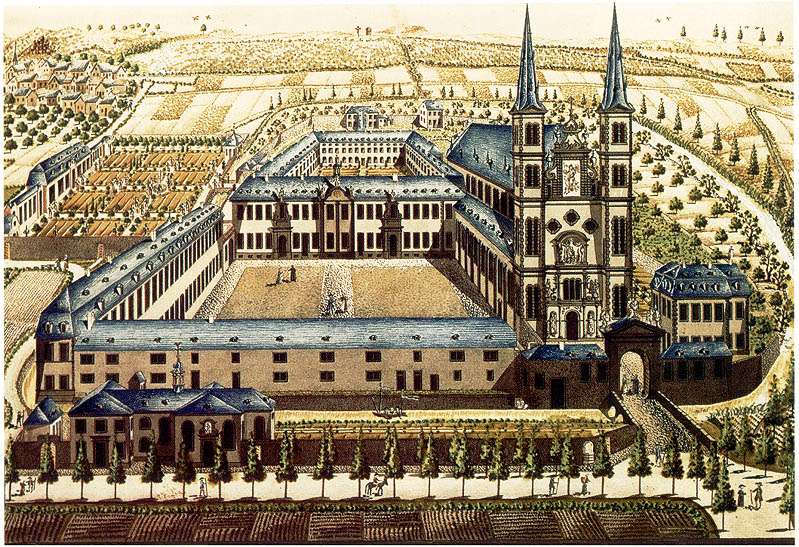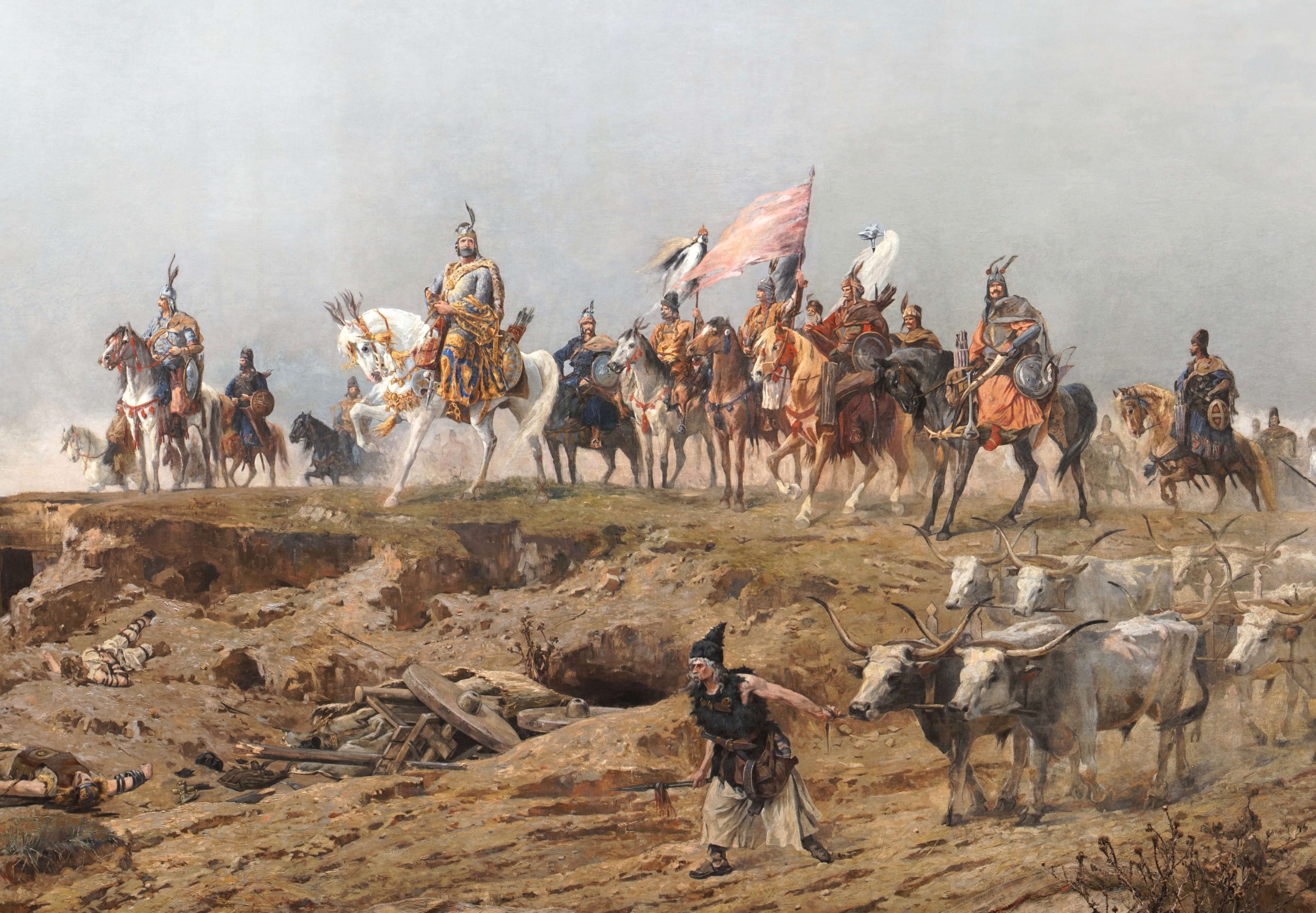|
Ruotbert
Robert, also spelled Ruotbert or Rotbert (died 19 May 956), was the archbishop of Trier from 931 until his death. He played a leading role in the politics of both Germany and France, and especially of the Lotharingian territory in between. He was a patron of scholars and writers and a reformer of monasteries. Rise If Robert was the canonical age of thirty when elected bishop, he would have been born in 901 or earlier. This is most likely, since he was already the chancellor of the see of Trier under his predecessor, Rudgar. (In 938 he granted a lifetime ''precaria'' to his predecessor's niece, Ada, and her two sons.) Robert was originally from the Batavian region, perhaps a member of the Saxon nobility. His brother, Ansfried the elder, was said to have been the count of fifteen counties, including Toxandria, and his nephew's daughter was said to be related to the Unrochinger family. Robert was described by some records as a kinsman of Bruno the Great, a member of the Otton ... [...More Info...] [...Related Items...] OR: [Wikipedia] [Google] [Baidu] |
Rudgar
Ruotger, also spelled Rutger, Rudger or Rudgar (died 27 January 931), was the archbishop of Trier from 915. His archdiocese at first lay within the kingdom of West Francia, but after 925 it was annexed to East Francia, an event in which Ruotger played a major role. Biography Ruotger was born to a noble family, probably in Lotharingia, possibly from the region north of Metz, around Thionville. He had a brother named Beroald, a layman, who was accused by Eberwin of Tholey a century later of having usurped the abbey of Saint Martin in Trier after the death of Abbot Regino. He also had a wealthy niece in the Rizzigau. Nothing is known of Ruotger's life before his elevation to the archdiocese in 915. His predecessor, Radbod, died on 30 March that year. It is probable that Ruotger was chosen as his successor in a free election by the cathedral chapter, since in 928 the church had been granted that privilege by King Charles the Straightforward. Nonetheless, it is probable that the ... [...More Info...] [...Related Items...] OR: [Wikipedia] [Google] [Baidu] |
Ansfried (bishop Of Utrecht)
Saint Ansfried (also Ansfrid, Ansfridus) of Utrecht sometimes called Ansfried the younger (died 3 May 1010 near Leusden) was Count of Huy and the sword-bearer for Otto I, Holy Roman Emperor. He became Bishop of Utrecht in 995. He appears to have been the son or grandson of Lambert, a nobleman of the Maasgau, the area where he later founded the Abbey of Thorn. He also appears to have been related to various important contemporaries including the royal family. Life The principal source of information regarding Ansfried is the ''De diversitatem temporum'' by the Benedictine Albert of Metz, written around 1022. [...More Info...] [...Related Items...] OR: [Wikipedia] [Google] [Baidu] |
Robert Of Trier's Chalice, Paten And Ring
The name Robert is an ancient Germanic given name, from Proto-Germanic "fame" and "bright" (''Hrōþiberhtaz''). Compare Old Dutch ''Robrecht'' and Old High German ''Hrodebert'' (a compound of '' Hruod'' ( non, Hróðr) "fame, glory, honour, praise, renown" and ''berht'' "bright, light, shining"). It is the second most frequently used given name of ancient Germanic origin. It is also in use as a surname. Another commonly used form of the name is Rupert. After becoming widely used in Continental Europe it entered England in its Old French form ''Robert'', where an Old English cognate form (''Hrēodbēorht'', ''Hrodberht'', ''Hrēodbēorð'', ''Hrœdbœrð'', ''Hrœdberð'', ''Hrōðberχtŕ'') had existed before the Norman Conquest. The feminine version is Roberta. The Italian, Portuguese, and Spanish form is Roberto. Robert is also a common name in many Germanic languages, including English, German, Dutch, Norwegian, Swedish, Scots, Danish, and Icelandic. It can be use ... [...More Info...] [...Related Items...] OR: [Wikipedia] [Google] [Baidu] |
Thietmar Of Merseburg
Thietmar (also Dietmar or Dithmar; 25 July 9751 December 1018), Prince-Bishop of Merseburg from 1009 until his death, was an important chronicler recording the reigns of German kings and Holy Roman Emperors of the Ottonian (Saxon) dynasty. Two of Thietmar's great-grandfathers, both referred to as Liuthar, were the Saxon nobles Lothar II, Count of Stade, and Lothar I, Count of Walbeck. They were both killed fighting the Slavs at the Battle of Lenzen. Life Thietmar was a son of the Saxon count Siegfried I the Older of Walbeck (died 990) and his wife Kunigunde (died 997), daughter of Henry I the Bald, Count of Stade (House of Udonids). His father fought with Margrave Odo against Duke Mieszko I of Poland at the 972 Battle of Cedynia. At the time of Thietmar's birth, his family sided with the Ottonian duke Henry II of Bavaria ("the Wrangler") in his uprising against his cousin Emperor Otto II. Later, a balance was achieved; Siegfried became burgrave at Möckern and his brother ... [...More Info...] [...Related Items...] OR: [Wikipedia] [Google] [Baidu] |
Duisburg
Duisburg () is a city in the Ruhr metropolitan area of the western German state of North Rhine-Westphalia. Lying on the confluence of the Rhine and the Ruhr rivers in the center of the Rhine-Ruhr Region, Duisburg is the 5th largest city in North Rhine-Westphalia and the 15th-largest city in Germany. In the Middle Ages, it was a city-state and a member of the Hanseatic League, and later became a major centre of iron, steel, and chemicals industries. For this reason, it was heavily bombed in World War II. Today it boasts the world's largest inland port, with 21 docks and 40 kilometres of wharf. Status Duisburg is a city in Germany's Rhineland, the fifth-largest (after Cologne, Düsseldorf, Dortmund and Essen) of the nation's most populous federal state of North Rhine-Westphalia. Its 500,000 inhabitants make it Germany's 15th-largest city. Located at the confluence of the Rhine river and its tributary the Ruhr river, it lies in the west of the Ruhr urban area, Germany's larges ... [...More Info...] [...Related Items...] OR: [Wikipedia] [Google] [Baidu] |
Conrad The Red
Conrad ( – 10 August 955), called the Red (german: Konrad der Rote), was Duke of Lorraine from 944 until 953. He became the progenitor of the Imperial Salian dynasty. Life He was the son of Werner V (died about 935), a Franconian count in the Nahegau, Speyergau, and Wormsgau territories on the Upper Rhine. His mother presumably was Hicha, a daughter of the Hunfriding duke Burchard II of Swabia and his wife Regelinda of Zürich. The descent of Count Werner V, the first documented Salian, is uncertain; he probably was related to the Frankish Widonid dynasty, his father, Werner IV (Walaho), was married to an unknown sister of King Conrad I of Germany. In 941, Conrad appeared as his father's successor in the Rhenish counties and obtained additional territory in the Wetterau on the right bank of the Rhine. Conrad took his residence at Worms and rivalled with Archbishop Frederick of Mainz for supremacy in Rhenish Franconia. The Salian counts had been able to strengthen their posi ... [...More Info...] [...Related Items...] OR: [Wikipedia] [Google] [Baidu] |
Trier Maximin 18
Trier ( , ; lb, Tréier ), formerly known in English as Trèves ( ;) and Triers (see also names in other languages), is a city on the banks of the Moselle in Germany. It lies in a valley between low vine-covered hills of red sandstone in the west of the state of Rhineland-Palatinate, near the border with Luxembourg and within the important Moselle wine region. Founded by the Celts in the late 4th century BC as ''Treuorum'' and conquered 300 years later by the Romans, who renamed it ''Augusta Treverorum'' ("The City of Augustus among the Treveri"), Trier is considered Germany's oldest city. It is also the oldest seat of a bishop north of the Alps. Trier was one of the four capitals of the Roman Empire during the Tetrarchy period in the late 3rd and early 4th centuries. In the Middle Ages, the archbishop-elector of Trier was an important prince of the Church who controlled land from the French border to the Rhine. The archbishop-elector of Trier also had great signif ... [...More Info...] [...Related Items...] OR: [Wikipedia] [Google] [Baidu] |
Palatine Chapel, Aachen
The Palatine Chapel in Aachen is an early medieval chapel and remaining component of Charlemagne's Palace of Aachen in what is now Germany. Although the palace itself no longer exists, the chapel was preserved and now forms the central part of Aachen Cathedral. It is Aachen's major landmark and a central monument of the Carolingian Renaissance. The chapel held the remains of Charlemagne. Later it was appropriated by the Ottonians and coronations were held there from 936 to 1531. As part of Aachen Cathedral, the chapel is designated as a UNESCO World Heritage Site. History Charlemagne began the construction of the Palatine Chapel around 792, along with the building of the rest of the palace structures. It was consecrated in 805 by Pope Leo III in honour of the Virgin Mary. The building is a centrally planned, domed chapel. The east end had a square apse, and was originally flanked by two basilican structures, now lost but known through archaeology. The chapel was entered through ... [...More Info...] [...Related Items...] OR: [Wikipedia] [Google] [Baidu] |
Otto I Of Germany
Otto I (23 November 912 – 7 May 973), traditionally known as Otto the Great (german: Otto der Große, it, Ottone il Grande), was East Frankish king from 936 and Holy Roman Emperor from 962 until his death in 973. He was the oldest son of Henry the Fowler and Matilda of Ringelheim. Otto inherited the Duchy of Saxony and the kingship of the Germans upon his father's death in 936. He continued his father's work of unifying all German tribes into a single kingdom and greatly expanded the king's powers at the expense of the aristocracy. Through strategic marriages and personal appointments, Otto installed members of his family in the kingdom's most important duchies. This reduced the various dukes, who had previously been co-equals with the king, to royal subjects under his authority. Otto transformed the church in Germany to strengthen royal authority and subjected its clergy to his personal control. After putting down a brief civil war among the rebellious duchies, Otto defeated ... [...More Info...] [...Related Items...] OR: [Wikipedia] [Google] [Baidu] |
Principality Of Hungary
The (Grand) Principality of HungaryS. Wise BauerThe history of the medieval world: from the conversion of Constantine to the First Crusade W. W. Norton & Company, 2010, p. 586George H. HodosThe East-Central European region: an historical outline Greenwood Publishing Group, 1999, p. 19 or Duchy of Hungary ( hu, Magyar Nagyfejedelemség: "Hungarian Grand Principality" Byzantine gr, Τουρκία) was the earliest documented Hungarian state in the |
Duchy Of Bavaria
The Duchy of Bavaria (German: ''Herzogtum Bayern'') was a frontier region in the southeastern part of the Merovingian kingdom from the sixth through the eighth century. It was settled by Bavarian tribes and ruled by dukes (''duces'') under Frankish overlordship. A new duchy was created from this area during the decline of the Carolingian Empire in the late ninth century. It became one of the stem duchies of the East Frankish realm which evolved as the Kingdom of Germany and the Holy Roman Empire. During internal struggles of the ruling Ottonian dynasty, the Bavarian territory was considerably diminished by the separation of the newly established Duchy of Carinthia in 976. Between 1070 and 1180 the Holy Roman Emperors were again strongly opposed by Bavaria, especially by the ducal House of Welf. In the final conflict between the Welf and Hohenstaufen dynasties, Duke Henry the Lion was banned and deprived of his Bavarian and Saxon fiefs by Emperor Frederick Barbarossa. Fr ... [...More Info...] [...Related Items...] OR: [Wikipedia] [Google] [Baidu] |





.jpg)
